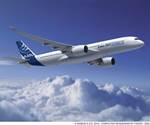Panelized option attested early on
Airbus' (Toulouse, France) use of large composite panels attached to frames in the A350 fuselage — is comparable to the optimal design conclusion reached by the Advanced Technology Composite Aircraft Structures (ATCAS) program back in the late 1990s.
Although it was developed independently by Airbus (Toulouse, France), this approach to constructing the A350 XWB’s fuselage sections — the use of large composite panels attached to frames — is comparable to the optimal design conclusion reached by the Advanced Technology Composite Aircraft Structures (ATCAS) program back in the late 1990s. ATCAS was part of the National Aeronautics and Space Admin.’s (NASA) Advanced Composites Technology (ACT) initiative in the U.S. Under the ACT mandate, the development of an all-composite commercial transport aircraft was split between two parallel programs: McDonnell Douglas Aerospace Co. (Long Beach, Calif.) was tasked with the design and development of a full-scale all-composite wing, and the ATCAS program, conducted by Boeing Commercial Airplanes (Seattle, Wash.), was to do the same for a composite fuselage. According to publicly released reports in 1997 and 1998 by ATCAS’s technical leader Peter Smith and principal investigator/structural engineer Dr. Larry Ilcewicz (currently the Federal Aviation Admin.’s national resource specialist for advanced composite materials) each area of a composite fuselage (crown, sides and keel) presents unique structural design challenges. The crown panel is primarily governed by tension loading, the sides are dominated by shear and pressure load redistribution around windows and doors, and the keel is subject to complex loading dominated by axial compression and load redistribution from the keel beam. The reports also note that the panel-and-frame approach reduces panel assembly costs because it requires fewer longitudinal splices and leverages the size efficiencies of automated fiber placement (AFP) manufacturing while maintaining design flexibility within each uniquely loaded area.
Related Content
-
Low-cost, efficient CFRP anisogrid lattice structures
CIRA uses patented parallel winding, dry fiber, silicone tooling and resin infusion to cut labor for lightweight, heavily loaded space applications.
-
First Airbus A350 crash confirmed in Haneda
Shortly after touch-down, a JAL A350-900 aircraft recently collided with a De Havilland Canada Dash 8. Exact circumstances are still unknown.
-
“Structured air” TPS safeguards composite structures
Powered by an 85% air/15% pure polyimide aerogel, Blueshift’s novel material system protects structures during transient thermal events from -200°C to beyond 2400°C for rockets, battery boxes and more.



